Designing Perennial Landscapes: Plant Form and Species Richness Influence the Gaze Perception Associated with Aesthetic Preference
Abstract
1. Introduction
2. Materials and Methods
2.1. Materials
2.2. Experimental Protocol
2.2.1. Participants
2.2.2. Equipment
2.2.3. Procedure
2.3. Statistical Analysis
2.3.1. Analysis of Gaze Data
- Yconverted is the data of normal distribution after conversion
- MAXrec is the maximum value of each group of recorded eye-tracking data
- Xrec is the original recorded eye-tracking data
- Yconverted is the data of normal distribution after conversion
- Xrec is the original recorded eye-tracking data
2.3.2. Analysis of the Questionnaire Data
3. Results
3.1. The Impact of Formal Aesthetic Characteristics on Fixation Behavior
3.2. Ratings Used to Assess Landscape Preference
3.3. Relationship between the Eye-Tracking Data and Ratings
3.4. The Differences in Fixation and Ratings in Terms of Personal Characteristics
4. Discussion
4.1. Plant Form and Species Richness Influence the Gaze Behavior towards Perennial Landscapes
4.2. Perspectives on Attention Restoration Theory: Aesthetic Preference May Be an Accelerator to Promote the Interaction with Landscape
4.3. Demographic Profile
4.4. Future Perspectives
5. Conclusions
Author Contributions
Funding
Data Availability Statement
Acknowledgments
Conflicts of Interest
References
- Haviland-Jones, J.; Rosario, H.H.; Wilson, P.; McGuire, T.R. An environmental approach to positive emotion: Flowers. Evol. Psychol. 2005, 3, 147470490500300109. [Google Scholar] [CrossRef]
- Honold, J.; Lakes, T.; Beyer, R.; van der Meer, E. Restoration in urban spaces: Nature views from home, Greenways, and Public Parks. Environ. Behav. 2016, 48, 796–825. [Google Scholar] [CrossRef]
- Sonntag-Ostrom, E.; Stenlund, T.; Nordin, M.; Lundell, Y.; Ahlgren, C.; Fjellman-Wiklund, A.; Jarvholm, L.S.; Dolling, A. “Nature’s effect on my mind”—Patients’ qualitative experiences of a forest-based rehabilitation programme. Urban For. Urban Green. 2015, 14, 607–614. [Google Scholar] [CrossRef]
- Dobson, J. Wellbeing and blue-green space in post-pandemic cities: Drivers, debates and departures. Geogr. Compass 2021, 15, e12593. [Google Scholar] [CrossRef]
- Vega, K.A.; Kuffer, C. Promoting wildflower biodiversity in dense and green cities: The important role of small vegetation patches. Urban For. Urban Green. 2021, 62, 127165. [Google Scholar] [CrossRef]
- Wahba, S.N. Can cities bounce back better from COVID-19? Reflections from emerging post-pandemic recovery plans and trade-offs. Environ. Urban. 2022, 34, 481–496. [Google Scholar] [CrossRef]
- Weber, F.; Kowarik, I.; Saeumel, I. A walk on the wild side: Perceptions of roadside vegetation beyond trees. Urban For. Urban Green. 2014, 13, 205–212. [Google Scholar] [CrossRef]
- Rajoo, K.S.; Karam, D.S.; Wook, N.-F.; Abdullah, M.-Z. Forest Therapy: An environmental approach to managing stress in middle-aged working women. Urban For. Urban Green. 2020, 55, 126853. [Google Scholar] [CrossRef]
- Meyer-Grandbastien, A.; Burel, F.; Hellier, E.; Bergerot, B. A step towards understanding the relationship between species diversity and psychological restoration of visitors in urban green spaces using landscape heterogeneity. Landsc. Urban Plan. 2020, 195, 103728. [Google Scholar] [CrossRef]
- Keith, S.J.; Boley, B.B. Importance-performance analysis of local resident greenway users: Findings from Three Atlanta BeltLine Neighborhoods. Urban For. Urban Green. 2019, 44, 126426. [Google Scholar] [CrossRef]
- Lima, M.F.; Ward Thompson, C.; Aspinall, P. Friendly Communities and Outdoor Spaces in Contexts of Urban Population Decline. Land 2020, 9, 439. [Google Scholar] [CrossRef]
- Zhuang, J.; Qiao, L.; Zhang, X.; Su, Y.; Xia, Y. Effects of visual attributes of flower borders in urban vegetation landscapes on aesthetic preference and emotional perception. Int. J. Environ. Res. Public Health 2021, 18, 9318. [Google Scholar] [CrossRef] [PubMed]
- Alizadeh, B.; Hitchmough, J. How will climate change affect future urban naturalistic herbaceous planting? The role of plant origin and fitness. Urban For. Urban Green. 2020, 54, 126786. [Google Scholar] [CrossRef]
- Koeppler, M.-R.; Hitchmough, J.D. Ecology good, aut-ecology better; improving the sustainability of designed plantings. J. Landsc. Archit. 2015, 10, 82–91. [Google Scholar] [CrossRef]
- Koerner, S.; Bellin-Harder, F.; Huxmann, N. Richard Hansen and modern planting design. J. Landsc. Archit. 2016, 11, 18–29. [Google Scholar] [CrossRef]
- Texixira, C.P.; Fernandes, C.O.; Ahern, J. Adaptive planting design and management framework for urban climate change adaptation and mitigation. Urban For. Urban Green. 2022, 70, 127548. [Google Scholar] [CrossRef]
- Ulrich, R.S. Human responses to vegetation and landscapes. Landsc. Urban Plan. 1986, 13, 29–44. [Google Scholar] [CrossRef]
- Georgiou, D.; Carspecken, P.F.; Willems, E.P. An expansion of Roger Barker’s behavior setting survey for an ethno-ecological approach to person-environment interactions. J. Environ. Psychol. 1996, 16, 319–333. [Google Scholar] [CrossRef]
- Valtchanov, D.; Ellard, C.G. Cognitive and affective responses to natural scenes: Effects of low level visual properties on preference, cognitive load and eye-movements. J. Environ. Psychol. 2015, 43, 184–195. [Google Scholar] [CrossRef]
- Lang, J. Symbolic aesthetics in architecture: Toward a research agenda. In Environmental Aesthetics: Theory, Research, and Application; Nasar, J., Ed.; Cambridge University Press: New York, NY, USA, 1988; pp. 11–26. [Google Scholar]
- Yilmaz, S.; Ozguner, H.; Mumcu, S. An aesthetic approach to planting design in urban parks and greenspaces. Landsc. Res. 2018, 43, 965–983. [Google Scholar] [CrossRef]
- Oleksiichenko, N.; Gatalska, N.; Mavko, M.; Ostapchuk, O. The role of woody plants in the formation of figurative and symbolic structure of memorial parks. Landsc. Archit. Art 2019, 14, 78–88. [Google Scholar] [CrossRef]
- DiSabato-Aust, T. The well-designed mixed garden: Building beds and borders with trees, shrubs, perennials, annuals, and bulbs. Libr. J. 2003, 128, 109. [Google Scholar]
- Huang, A.S.-H.; Lin, Y.-J. The effect of landscape colour, complexity and preference on viewing behaviour. Landsc. Res. 2020, 45, 214–227. [Google Scholar] [CrossRef]
- Lindemann-Matthies, P.; Junge, X.; Matthies, D. The influence of plant diversity on people’s perception and aesthetic appreciation of grassland vegetation. Biol. Conserv. 2010, 143, 195–202. [Google Scholar] [CrossRef]
- Lamb, R.J.; Purcell, A.T. Perception of naturalness in landscape and its relationship to vegetation structure. Landsc. Urban Plan. 1990, 19, 333–352. [Google Scholar] [CrossRef]
- Krzeptowska-Moszkowicz, I.; Moszkowicz, Ł.; Porada, K. Urban Sensory Gardens with Aromatic Herbs in the Light of Climate Change: Therapeutic Potential and Memory-Dependent Smell Impact on Human Wellbeing. Land 2022, 11, 760. [Google Scholar] [CrossRef]
- Misgav, A. Visual preference of the public for vegetation groups in Israel. Landsc. Urban Plan. 2000, 48, 143–159. [Google Scholar] [CrossRef]
- Todorova, A.; Asakawa, S.; Aikoh, T. Preferences for and attitudes towards street flowers and trees in Sapporo, Japan. Landsc. Urban Plan. 2004, 69, 403–416. [Google Scholar] [CrossRef]
- Qiao, L.; Zhuang, J.; Zhang, X.; Su, Y.; Xia, Y. Assessing emotional responses to the spatial quality of urban green spaces through Self-report and Face Recognition measures. Int. J. Environ. Res. Public Health 2021, 18, 8526. [Google Scholar] [CrossRef]
- Daniel, T.C. Whither scenic beauty? Visual landscape quality assessment in the 21st century. Landsc. Urban Plan. 2001, 54, 267–281. [Google Scholar] [CrossRef]
- Cottet, M.; Vaudor, L.; Tronchere, H.; Roux-Michollet, D.; Augendre, M.; Brault, V. Using gaze behavior to gain insights into the impacts of naturalness on city dwellers’ perceptions and valuation of a landscape. J. Environ. Psychol. 2018, 60, 9–20. [Google Scholar] [CrossRef]
- Li, S.; Scott, N.; Walters, G. Current and potential methods for measuring emotion in tourism experiences: A review. Curr. Issues Tour. 2015, 18, 805–827. [Google Scholar] [CrossRef]
- Hannula, D.E.; Althoff, R.R.; Warren, D.E.; Riggs, L.; Cohen, N.J.; Ryan, J.D. Worth a glance: Using eye movements to investigate the cognitive neuroscience of memory. Front. Hum. Neurosci. 2010, 4, 166. [Google Scholar] [CrossRef] [PubMed]
- Holmes, T.; Zanker, J.M. Using an oculomotor signature as an indicator of aesthetic preference. i-Perception 2012, 3, 426–439. [Google Scholar] [CrossRef] [PubMed]
- Batool, A.; Rutherford, P.; McGraw, P.; Ledgeway, T.; Altomonte, S. View preference in urban environments. Light. Res. Technol. 2021, 53, 613–636. [Google Scholar] [CrossRef]
- Liu, Q.; Zhu, Z.; Zeng, X.; Zhuo, Z.; Ye, B.; Fang, L.; Huang, Q.; Lai, P. The impact of landscape complexity on preference ratings and eye fixation of various urban green space settings. Urban For. Urban Green. 2021, 66, 127411. [Google Scholar] [CrossRef]
- Palmer, J.F.; Hoffman, R.E. Rating reliability and representation validity in scenic landscape assessments. Landsc. Urban Plan. 2001, 54, 149–161. [Google Scholar] [CrossRef]
- Nordh, H.; Hagerhall, C.M.; Holmqvist, K. Tracking restorative components: Patterns in eye movements as a consequence of a restorative rating task. Landsc. Res. 2013, 38, 101–116. [Google Scholar] [CrossRef]
- Dupont, L.; Antrop, M.; Van Eetvelde, V. Eye-tracking Analysis in Landscape Perception Research: Influence of Photograph Properties and Landscape Characteristics. Landsc. Res. 2014, 39, 417–432. [Google Scholar] [CrossRef]
- Paraskevopoulou, A.T.; Kamperi, E.; Demiris, N.; Economou, M.; Theleritis, C.; Kitsonas, M.; Papageorgiou, C. The impact of seasonal colour change in planting on patients with psychotic disorders using biosensors. Urban For. Urban Green. 2018, 36, 50–56. [Google Scholar] [CrossRef]
- Oudolf, P.; Kingsbury, N. Planting: A New Perspective; Timber Press: Portland, OR, USA, 2016. [Google Scholar]
- Eroglu, E.; Muderrisoglu, H.; Kesim, G.A. The effect of seasonal change of plants compositions on visual perception. J. Environ. Eng. Landsc. Manag. 2012, 20, 196–205. [Google Scholar] [CrossRef]
- Ode, A.; Hagerhall, C.M.; Sang, N. Analysing visual landscape complexity: Theory and application. Landsc. Res. 2010, 35, 111–131. [Google Scholar] [CrossRef]
- Jorgensen, A.; Gobster, P.H. Shades of green: Measuring the ecology of urban green space in the context of human health and well-being. Nat. Cult. 2010, 5, 338–363. [Google Scholar] [CrossRef]
- Ulrich, R.S. Aesthetic and affective response to natural environment. In Behavior and the Natural Environment; Springer: Berlin/Heidelberg, Germany, 1983; pp. 85–125. [Google Scholar]
- De la Fuente de Val, G.; Atauri, J.A.; de Lucio, J.V. Relationship between landscape visual attributes and spatial pattern indices: A test study in Mediterranean-climate landscapes. Landsc. Urban Plan. 2006, 77, 393–407. [Google Scholar] [CrossRef]
- Stamps, A.E., III. On Shape and Spaciousness. Environ. Behav. 2009, 41, 526–548. [Google Scholar] [CrossRef]
- Stamps, A.E., III. Effects of Area, Height, Elongation, and Color on Perceived Spaciousness. Environ. Behav. 2011, 43, 252–273. [Google Scholar] [CrossRef]
- Shimojo, S.; Simion, C.; Shimojo, E.; Scheier, C. Gaze bias both reflects and influences preference. Nat. Neurosci. 2003, 6, 1317–1322. [Google Scholar] [CrossRef]
- Kaplan, S. Meditation, restoration, and the management of mental fatigue. Environ. Behav. 2001, 33, 480–506. [Google Scholar] [CrossRef]
- Berto, R.; Massaccesi, S.; Pasini, M. Do eye movements measured across high and low fascination photographs differ? Addressing Kaplan’s fascination hypothesis. J. Environ. Psychol. 2008, 28, 185–191. [Google Scholar] [CrossRef]
- Kaplan, S. The restorative benefits of nature: Toward an integrative framework. J. Environ. Psychol. 1995, 15, 169–182. [Google Scholar] [CrossRef]
- Franek, M.; Sefara, D.; Petruzalek, J.; Cabal, J.; Myska, K. Differences in eye movements while viewing images with various levels of restorativeness. J. Environ. Psychol. 2018, 57, 10–16. [Google Scholar] [CrossRef]
- Van den Berg, A.E.; Koole, S.L.; van der Wulp, N.Y. Environmental preference and restoration: (How) are they related? J. Environ. Psychol. 2003, 23, 135–146. [Google Scholar] [CrossRef]
- Sang, A.O.; Knez, I.; Gunnarsson, B.; Hedblom, M. The effects of naturalness, gender, and age on how urban green space is perceived and used. Urban For. Urban Green. 2016, 18, 268–276. [Google Scholar] [CrossRef]
- Dupont, L.; Antrop, M.; Van Eetvelde, V. Does landscape related expertise influence the visual perception of landscape photographs? Implications for participatory landscape planning and management. Landsc. Urban Plan. 2015, 141, 68–77. [Google Scholar] [CrossRef]
- Lindemann-Matthies, P.; Bose, E. Species richness, structural diversity and species composition in meadows created by visitors of a botanical garden in Switzerland. Landsc. Urban Plan. 2007, 79, 298–307. [Google Scholar] [CrossRef]
- Ode, A.; Fry, G.; Tveit, M.S.; Messager, P.; Miller, D. Indicators of perceived naturalness as drivers of landscape preference. J. Environ. Manag. 2009, 90, 375–383. [Google Scholar] [CrossRef] [PubMed]
- Kaplan, R.; Talbot, J.F. Ethnicity and preference for natural settings: A review and recent findings. Landsc. Urban Plan. 1988, 15, 107–117. [Google Scholar] [CrossRef]
- Tam, K.-P.; Milfont, T.L. Towards cross-cultural environmental psychology: A state-of-the-art review and recommendations. J. Environ. Psychol. 2020, 71, 101474. [Google Scholar] [CrossRef]
- Rink, D.; Arndt, T. Investigating perception of green structure configuration for afforestation in urban brownfield development by visual methods—A case study in Leipzig, Germany. Urban For. Urban Green. 2016, 15, 65–74. [Google Scholar] [CrossRef]
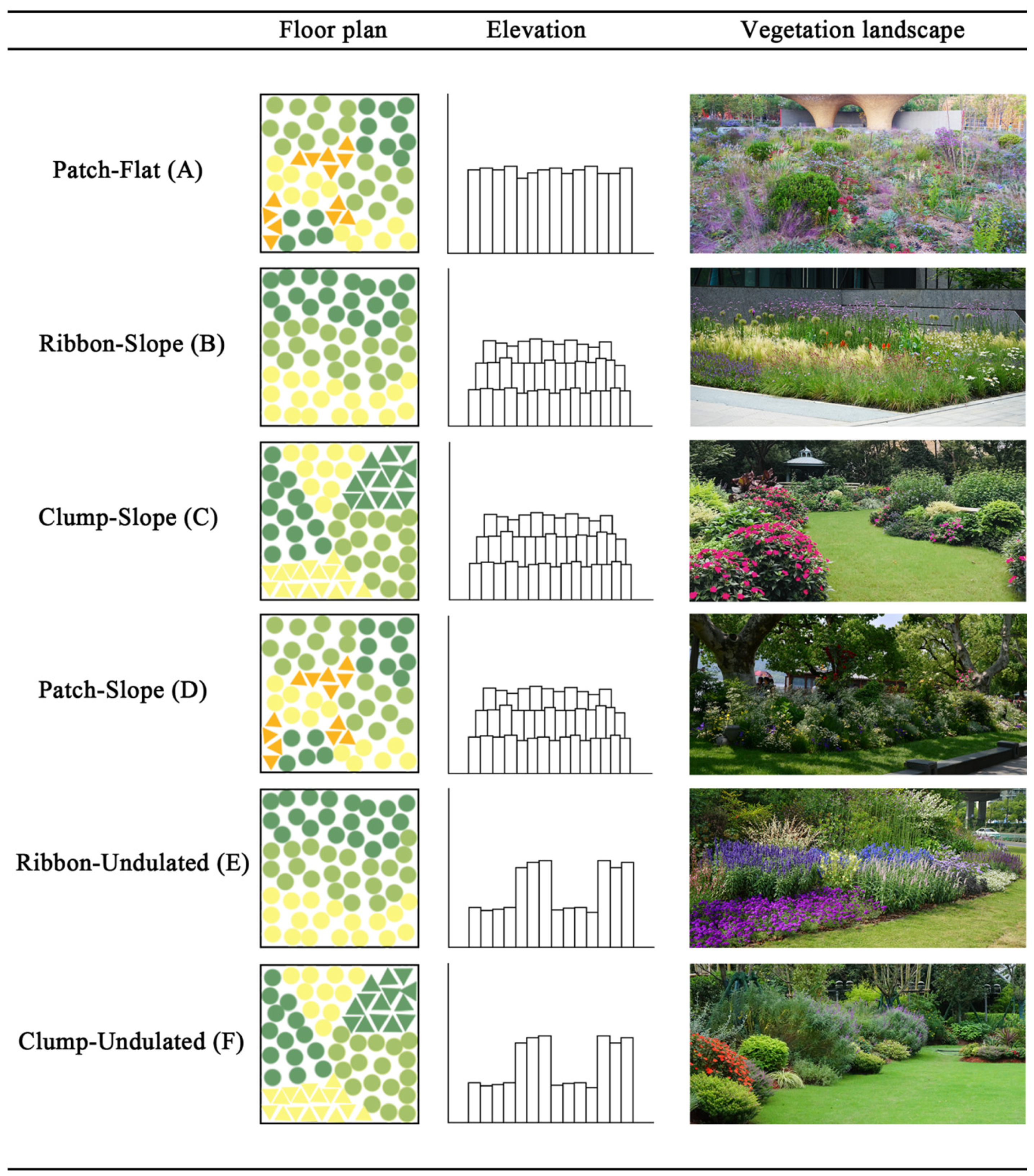
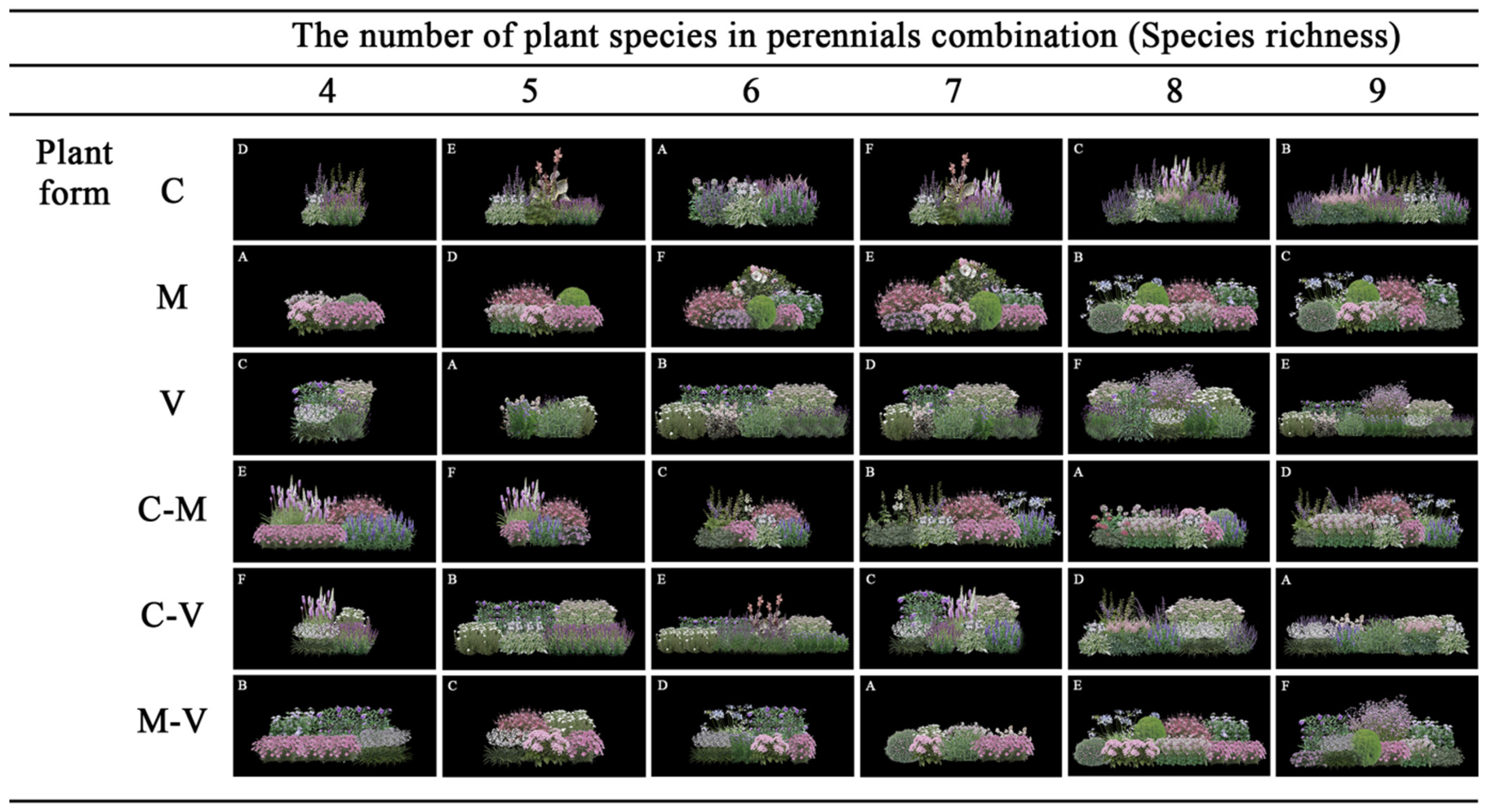
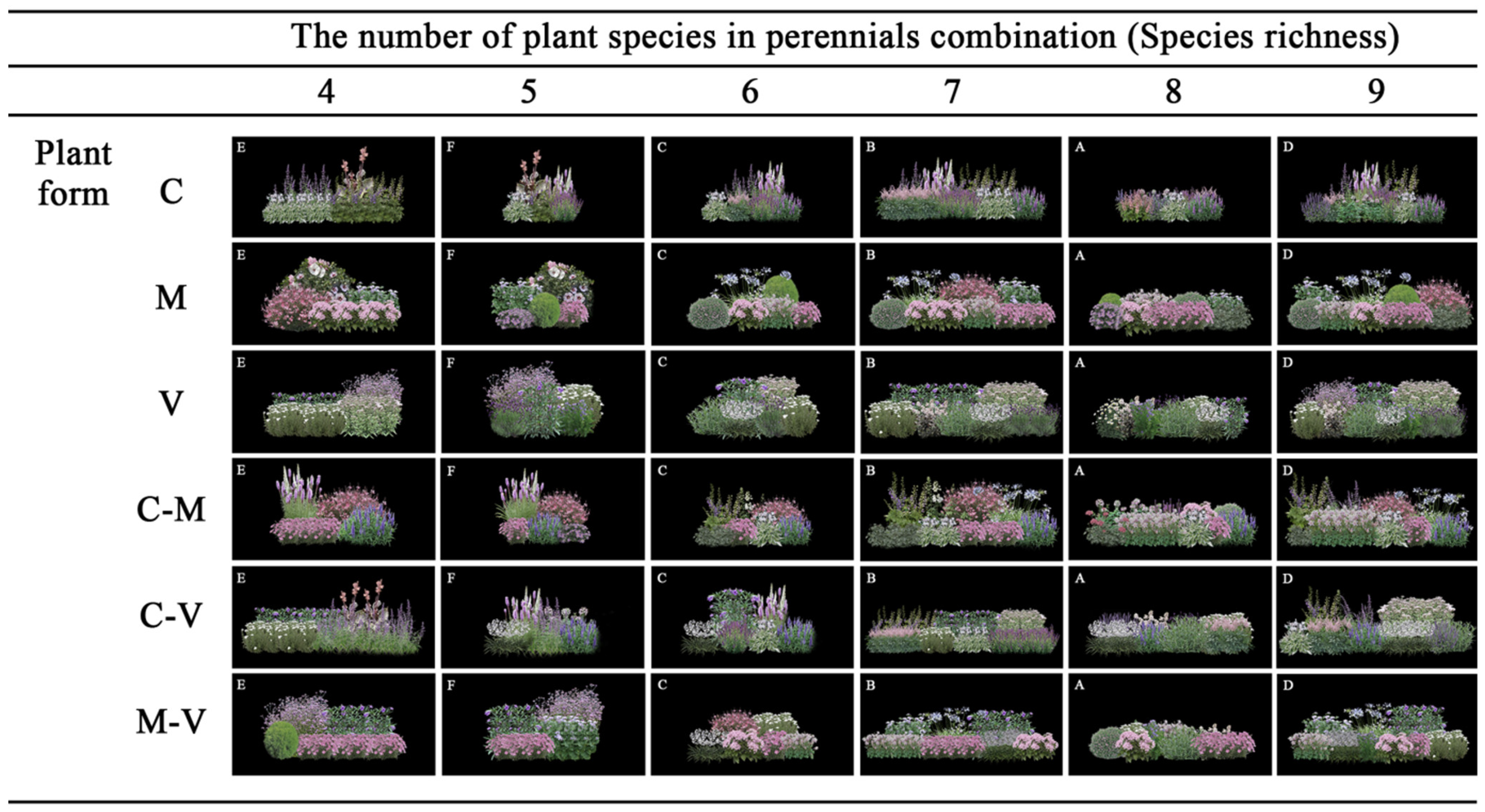

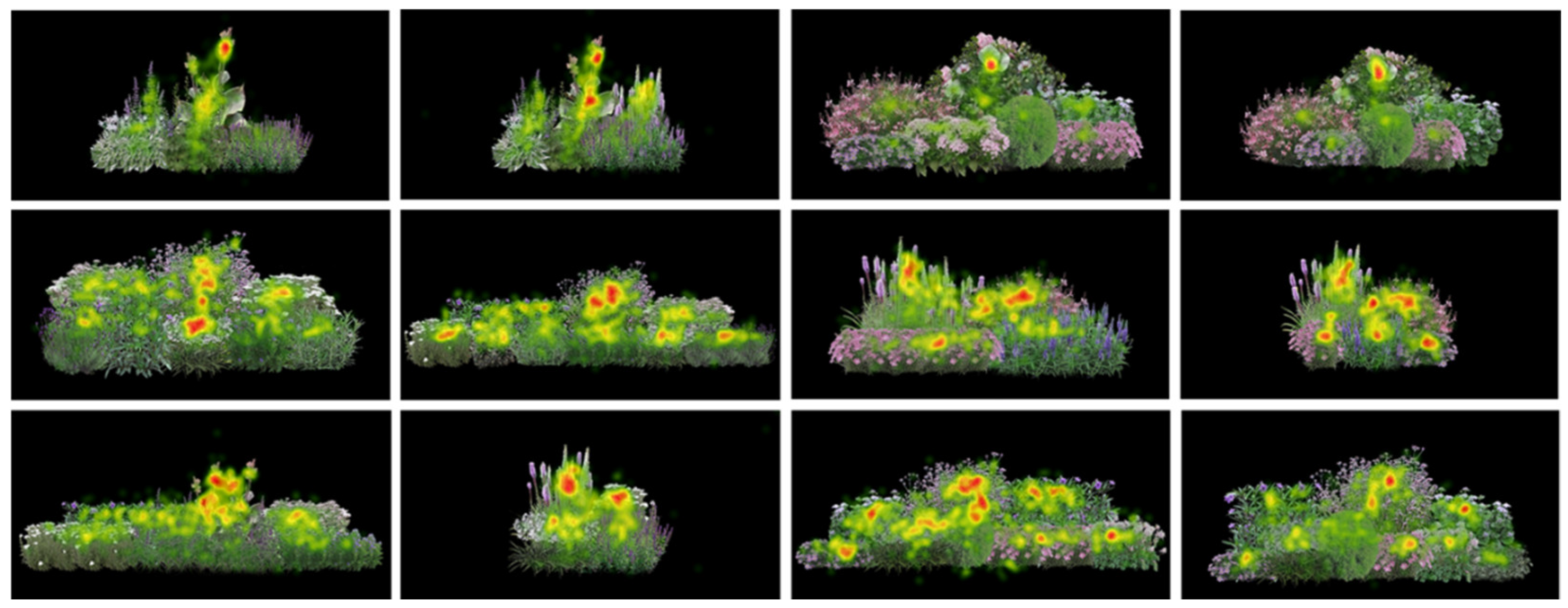

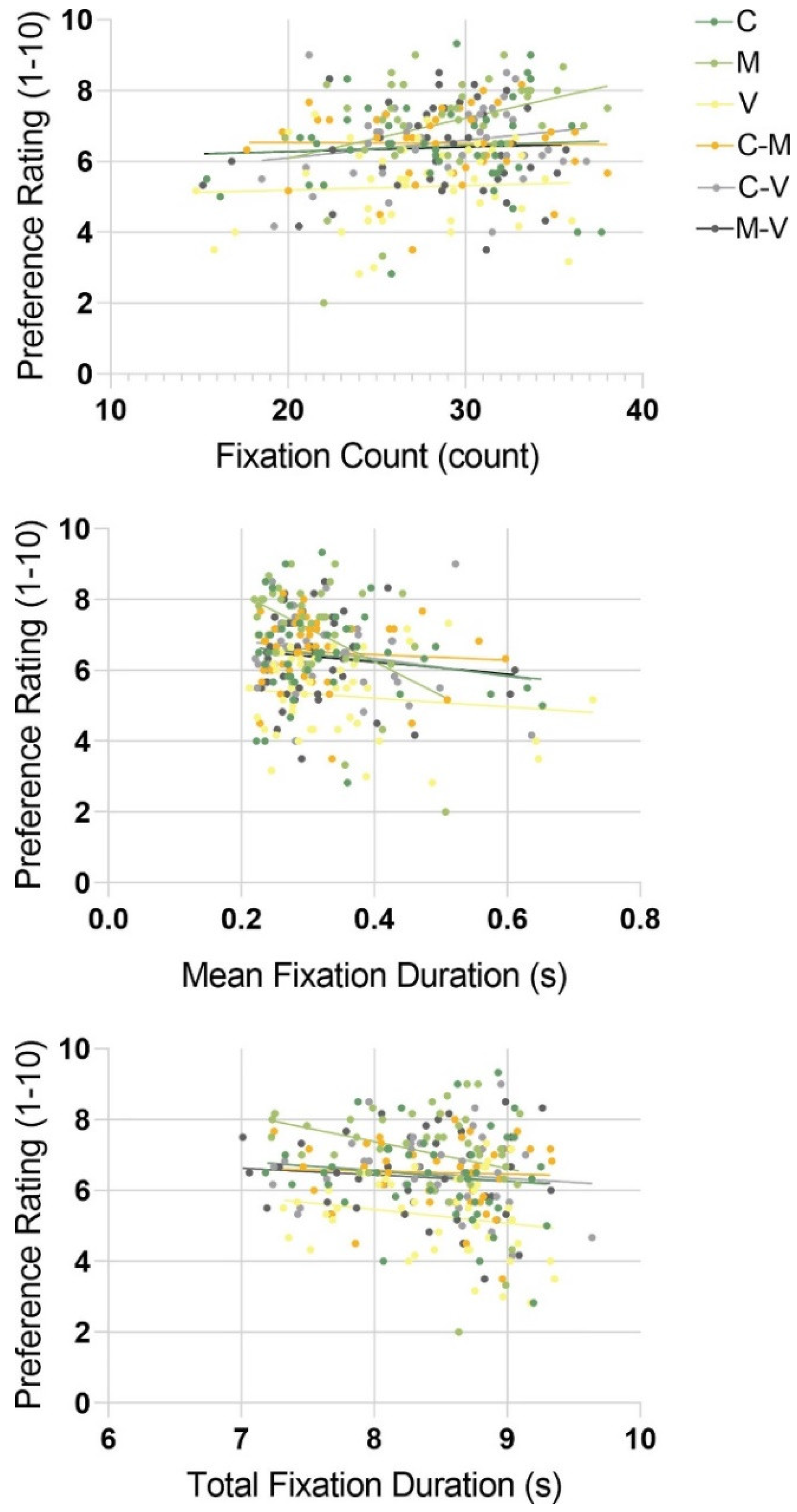
| Mounding (M) | Conical (C) | Vertical (V) |
|---|---|---|
| Brachyscome angustifolia | Hosta plantaginea | Ruellia simplex |
| Dianthus plumarius | Tarenaya hassleriana | Lavandula angustifolia |
| Gypsophila paniculata | Salvia nemorosa ‘Caradonna’ | Penstemon digitalis |
| Pelargonium hortorum | Pseudolysimachion spicatum | Achillea millefolium |
| Aquilegia viridiflora | Delphinium × cultorum | Rosmarinus officinalis |
| Pentas lanceolata | Salvia leucantha | Eupatorium cannabinum |
| Kochia scoparia | Liatris spicata | Verbena bonariensis |
| Ageratum conyzoides | Astilbe chinensis | Agastache rugosa |
| Agapanthus africanus | Salvia guaranitica ‘Black and Blue’ | Agapanthus africanus ‘Peter Pan’ |
| Gaura lindheimeri | ||
| Hibiscus grandiflorus |
| Fixation Count | Mean Fixation Duration | Total Fixation Duration | |
|---|---|---|---|
| Plant form | 0.298 | 0.039 * | 0.082 |
| Specie richness | 0.005 * | 0.002 * | 0.121 |
| Arrangement | 0.489 | 0.281 | 0.586 |
| Fixation Count | Mean Fixation Duration | Total Fixation Duration | |||||||||
|---|---|---|---|---|---|---|---|---|---|---|---|
| Subset | Subset | Subset | |||||||||
| Species richness | N | 1 | 2 | Species richness | N | 1 | 2 | Plant form | N | 1 | 2 |
| 4 | 177 | 27.14 | 8 | 179 | 0.2939 | M-V | 176 | 7.9879 | |||
| 5 | 177 | 27.34 | 9 | 180 | 0.3012 | 0.3012 | M | 178 | 8.0692 | 8.0692 | |
| 7 | 178 | 28.17 | 28.17 | 6 | 179 | 0.3177 | 0.3177 | V | 180 | 8.1322 | 8.1322 |
| 6 | 179 | 28.21 | 28.21 | 7 | 178 | 0.3181 | 0.3181 | C-V | 179 | 8.1350 | 8.1350 |
| 8 | 179 | 28.89 | 28.89 | 5 | 177 | 0.3273 | 0.3273 | C | 179 | 8.2152 | 8.2152 |
| 9 | 180 | 29.34 | 4 | 177 | 0.3396 | C-M | 178 | 8.3065 | |||
| Sig. | 0.09 | 0.49 | Sig. | 0.273 | 0.139 | Sig. | 0.098 | 0.073 | |||
| Preference Ratings | ||||
|---|---|---|---|---|
| Subset | ||||
| Plant Form | N | 1 | 2 | 3 |
| V | 258 | 5.28 | ||
| M-V | 258 | 6.38 | ||
| C | 258 | 6.42 | ||
| C-V | 258 | 6.48 | ||
| C-M | 258 | 6.51 | ||
| M | 258 | 7.11 | ||
| Sig. | 1.000 | 0.952 | 1.000 | |
| Landscape Preference | |
|---|---|
| Fixation count | 0.098 ** |
| Mean fixation duration | −0.117 ** |
| Total fixation duration | −0.124 ** |
| Mean Rank | ||||||
|---|---|---|---|---|---|---|
| Gender | Profession | |||||
| Men | Women | p | Professionals | Non-Professionals | p | |
| Fixation count | 688.08 | 850.47 | 0.000 * | 766.15 | 767.87 | 0.939 |
| Mean fixation duration | 833.07 | 697.11 | 0.000 * | 757.54 | 776.77 | 0.395 |
| Total fixation duration | 772.93 | 760.73 | 0.590 | 753.44 | 781.01 | 0.223 |
| Landscape preference rating | 789.05 | 759.26 | 0.183 | 736.19 | 814.63 | 0.000 * |
Publisher’s Note: MDPI stays neutral with regard to jurisdictional claims in published maps and institutional affiliations. |
© 2022 by the authors. Licensee MDPI, Basel, Switzerland. This article is an open access article distributed under the terms and conditions of the Creative Commons Attribution (CC BY) license (https://creativecommons.org/licenses/by/4.0/).
Share and Cite
Shi, Y.; Zhang, J.; Shen, X.; Chen, L.; Xu, Y.; Fu, R.; Su, Y.; Xia, Y. Designing Perennial Landscapes: Plant Form and Species Richness Influence the Gaze Perception Associated with Aesthetic Preference. Land 2022, 11, 1860. https://doi.org/10.3390/land11101860
Shi Y, Zhang J, Shen X, Chen L, Xu Y, Fu R, Su Y, Xia Y. Designing Perennial Landscapes: Plant Form and Species Richness Influence the Gaze Perception Associated with Aesthetic Preference. Land. 2022; 11(10):1860. https://doi.org/10.3390/land11101860
Chicago/Turabian StyleShi, Yangyang, Jiao Zhang, Xinyue Shen, Liang Chen, Yunchen Xu, Rui Fu, Yang Su, and Yiping Xia. 2022. "Designing Perennial Landscapes: Plant Form and Species Richness Influence the Gaze Perception Associated with Aesthetic Preference" Land 11, no. 10: 1860. https://doi.org/10.3390/land11101860
APA StyleShi, Y., Zhang, J., Shen, X., Chen, L., Xu, Y., Fu, R., Su, Y., & Xia, Y. (2022). Designing Perennial Landscapes: Plant Form and Species Richness Influence the Gaze Perception Associated with Aesthetic Preference. Land, 11(10), 1860. https://doi.org/10.3390/land11101860








